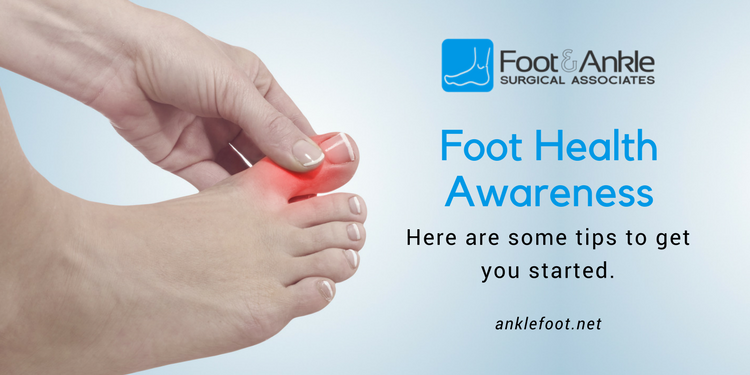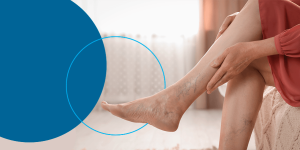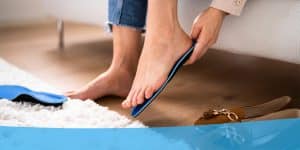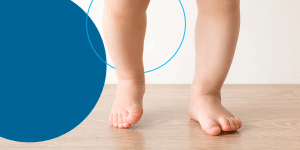Did you know that April is National Foot Health Awareness Month?
Yeah, yeah, we know. April is more than half over. But you’ve still got plenty of time to catch up! Plus, you’ll be developing habits that will serve you and your feet well for years to come.
You see, the way you care for your feet on a day-to-day basis can make a huge difference in both the short and long term. Not only will you be less likely to deal with minor aches and pains, or athlete’s foot, but you’re also less likely to develop long-term, chronic pain and deformity (heel pain, bunions, hammertoes, etc.).
And your feet have to last a lifetime. You could easily rack up over 100,000 miles (around the Earth four times, for the sake of comparison) by the time you’re done. The longer they hold up, the fitter, more active, and more independent you can be—at every age!
It’s not hard to take care of your feet. But you need to know how! Here are some tips to get you started.
Hygiene and Maintenance
Keeping your feet clean and well cared for with routine inspection and maintenance is the foundation of long-term foot health.
–Wash your feet with mild soap and water every single day.
–Dry your feet thoroughly after your bath or shower. Don’t forget to get in between your toes!
-Most people should apply a moisturizer after drying their feet to help protect their skin. You can get the tops, sides, and soles of feet. But you should avoid the spaces between the toes.
-Never wear socks and shoes that have become damp or waterlogged. If you get caught in some rain or just sweat a lot, you might have to change in the middle of the day. Damp footwear becomes a breeding ground for harmful fungi, viruses, and bacteria.
–Keep your toenails neatly trimmed. There’s a bit of a trick to this—don’t cut them too short, and don’t round the corners like you would with your fingernails. Both can increase the risk of ingrown toenails.
-Examine your feet every day. This is especially important if you have diabetes, neuropathy, or any other condition that may affect the sensation and/or circulation in your feet. Identify and address concerns like blisters, cuts, dry skin, rashes, etc. quickly. If you do have diabetes, schedule an appointment with us for follow up if you notice any sores.
Finding Proper Footwear
We spend most of our day in shoes. Footwear that fits properly and offers the right support for what we’re doing can make the day a lot more comfortable. Bad shoes, however, can cause pain and even accelerate the development of foot deformities.
-Rotate shoes. Ideally you should give each pair a minimum “dry time” of 24 hours before wearing them again, to discourage the growth of fungi and other germs. You may wish to apply an antifungal powder or spray as well.
–Only wear shoes that fit. Seems obvious, but a lot of us are willing to stuff feet into shoes that are too small or too big in the service of fashion or style.
-Replace old shoes. Shoes wear down over time with heavy wear. That includes the cushioning in the midsole and insole, which in turn increases the pressure and impact forces on your feet.
-Buy shoes specific to your sport or activity. Basketball places very different demands on your feet than running—or soccer, tennis, ballet, hiking, etc. Having a pair of shoes or boots specifically designed activities you regularly engage in will help you play better and reduce the risk of injury.
-Go shoe shopping late in the day. Feet have a tendency to swell a bit at the end of a long day, making them a bit larger than they are in the morning. So, if you shop in the evening, you’ll be sure your shoes will still fit even if you’re a little swollen.
-Measure your feet every time. Feet do slowly increase in size even through middle and late adulthood—usually getting flatter and wider over time. So always measure in case you need an extra half size or greater width than before.
-Wear appropriate socks when you try on shoes. The socks you wear when trying on shoes should be of the same type that you’d wear with them regularly. After all, the width of the sock affects the fit of the shoe on your feet.
-New shoes ought to be comfy and easy to wear right away. Don’t be tempted to rationalize buying a tight, uncomfortable pair thinking that they’ll “break in.” They won’t. If your shoes aren’t comfy when they’re brand new, they’re going to hurt your feet.
Caring for Problems in a Timely Fashion
One thing we hear over and over again at our office is, “I wish I had called sooner!”
Foot pain is never a “normal” thing, regardless of how old you are or what your medical history looks like. If something hurts, it’s your body’s way of saying there’s a problem.
With foot pain, it’s especially important you seek help right away, for two big reasons:
1) Feet are at the foundation of nearly everything you do. When your feet hurt, you don’t exercise, you don’t play, you don’t enjoy the little things nearly as much as you used to. Declining mobility and activity that results from foot problems can then snowball into more serious health issues.
2) Many painful foot conditions won’t go away on their own unless you do something to treat them. Often, injuries or deformities will just get worse and worse over time. And when the problems are worse, they’re often harder to treat later.
If your feet hurt, or if you develop a rash or other infection, and home care isn’t working, please don’t drag your feet. Give us a call. Alongside traditional podiatric care, we also provide more advanced and effective services and treatment options, such as:
1) Advanced diagnostic tools, including X-ray, ultrasound, and weight-bearing CT scanning
2) Physical therapy and massage
3) Custom-molded orthotics
4) Foot surgery
To schedule an appointment with the Foot & Ankle Surgical Associates at any of our five convenient clinic locations, give us a call at (360) 754-3338 today.





